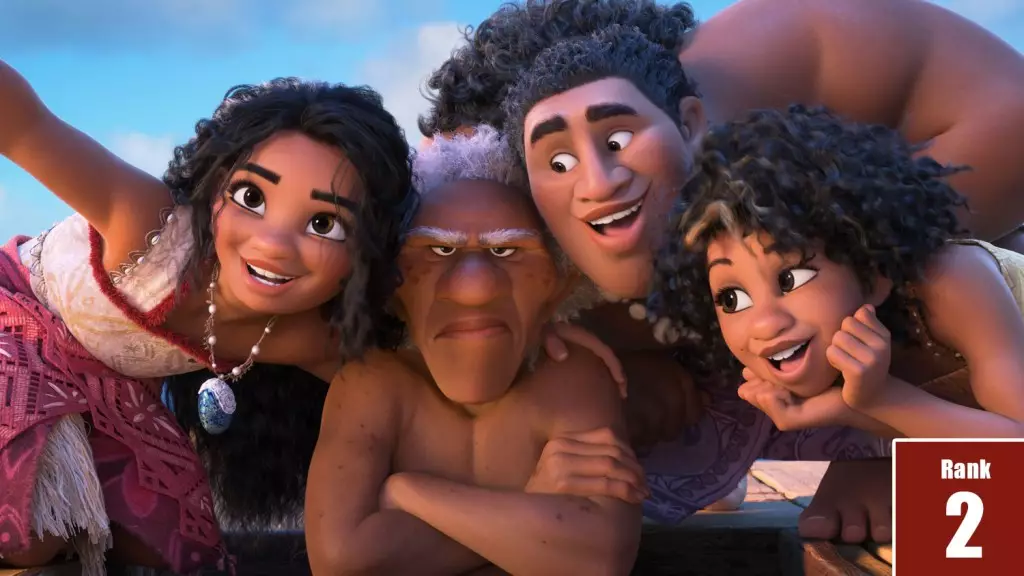Disney has long held the title of Hollywood titan, consistently delivering family-friendly animated films that captivate audiences worldwide. However, the recent release of Moana 2 signals a significant shift in strategy for the studio. After faltering under the leadership of former CEO Bob Chapek, who leaned heavily on streaming platforms during the pandemic, Disney has recalibrated its focus and revitalized its theatrical releases. The movie’s five-day Thanksgiving debut, which raked in an astounding $225.4 million, not only shattered records but also set the stage for a more aggressive return to theaters, emphasizing the longevity of the cinematic experience.
The impressive financial performance is not merely the result of pent-up demand; it reflects a strategic maneuver that recognizes the value of theatrical windows. Disney’s commitment to a 62-day period before transitioning to Premium VOD may seem conservative, but it shows a clear understanding of how to maximize profits in today’s marketplace. It recognizes that there is still a significant audience willing to experience films in theaters, a sentiment that could reinvigorate the industry as a whole. Many studios must take note of this revival strategy if they wish to compete in the post-COVID cinematic landscape.
The Creative Challenges Behind Moana 2
Despite its commercial success, the production of Moana 2 was not without its challenges. The decision to replace Lin-Manuel Miranda, the Oscar-nominated songwriter for the first film, raised eyebrows among fans who had expected a continuation of the celebrated musical style. This shift to the songwriters Abigail Barlow and Emily Bear represents a bold, if risky, move for Disney. If the new music fails to resonate with the audience, it could tarnish the legacy of Moana and diminish the excitement generated by this highly anticipated sequel.
Nevertheless, the choice also reveals a willingness to innovate and adapt. Under the watchful eye of CEO Bob Iger, who actively advocates for Disney’s storied legacy, there is hope that Barlow and Bear’s fresh perspective will breathe new life into the franchise. The successful re-engagement of the original star duo, Dwayne Johnson as Maui and Auli’i Cravalho as Moana, further signals that the studio is keen on tapping into nostalgia while also exploring new creative avenues.
Competition in the Holiday Marketplace
Even with unprecedented success, Moana 2 did not emerge in a vacuum. Disney’s decision to compete head-on with the anticipated release of *Wicked* during the Thanksgiving frame reveals a fascinating backdrop to the film’s box office triumph. Rather than viewing their theatrical windows as isolated ventures, studios must consider the broader marketplace and how a rising tide can lift all boats. The market’s capacity seems not just to accommodate multiple blockbusters, but to thrive on the diversity of offerings.
The return of families to theaters is telling; it suggests that audiences are eager to engage with familiar franchises in the cinematic space rather than relying solely on streaming options. In the current landscape, where digital releases often overshadow theatrical runs, the sheer numbers behind *Moana 2* are a clarion call to Hollywood that the magic of cinema is still alive and profitable.
The Post-Cinema Financial Landscape
Critically, it’s essential to understand that Moana 2’s financial success extends beyond box office receipts. The vibrant merchandise sales surrounding the film underline the multifaceted revenue streams that animated features can generate. Estimates indicate that the toy and apparel lines connected to the film have become significant profit centers, effectively turning *Moana 2* into more than just a cinematic product. This model illustrates a vital lesson for the broader industry—entertainment is increasingly about cultivating both consumption and engagement across multiple platforms.
What complicates this further is the varying financial expectations across different types of releases. While a traditional blockbuster might get evaluated purely on box office performance, *Moana 2* must also be assessed on merchandise revenue and its potential in streaming. This expanded viewpoint could encourage studios to look beyond the initial box office returns, a critical evolution in how success is quantified in a transformed entertainment landscape.
An Insight Into Disney’s Future
In the coming years, Disney’s approach with *Moana 2* could serve as a blueprint for future projects. This combination of nostalgic appeal, strategic decision-making, and diversified revenue streams offers a multifaceted approach to filmmaking. The success of this sequel may not be merely a one-off event, but rather a sign of a renewed vigor at Disney, pointing to a brighter future for theatrical cinema as audiences increasingly seek entertainment that offers a communal experience.
The factors driving the success of Moana 2 echo the broader narrative that audiences are hungry for quality storytelling delivered on the big screen—provided studios respect and nurture that audience. As the industry continues to navigate the challenges of modern filmmaking, Disney’s recent successes demonstrate a critical lesson: the magic of cinema still exists, waiting to be harnessed.

